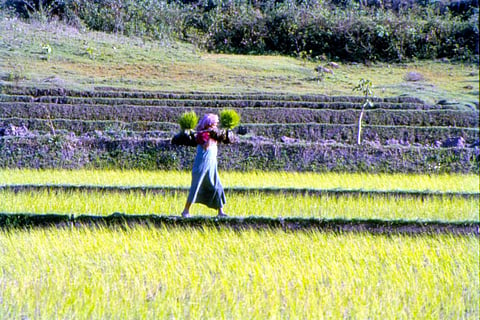A farmer becomes a labourer
By next year, India has a promise to keep: To double farmers’ income from 2015-2016 levels. The 77th round of the National Sample Survey, Land and Livestock Holdings of Households and Situation Assessment of Agricultural Households, by the National Statistical Office has some indicators on whether this promise can be kept.
The survey covers situations in 2018-2019; before this a similar survey was done in 2012-2013. Thus, this survey is also the first to point out the state of farmers during the tenure of the incumbent government.
Monthly income of agricultural households has increased by 59 per cent since 2012-2013. So, it is an annual growth rate of 7.8 per cent. To get a real sense of this growth one has to factor in the annual inflation rate. The inflation-adjusted growth rate in income is 2.5 per cent.
The survey also shows that income from cultivation has come down during these two survey rounds — during 2012-2018.
There are three sources of income for an agricultural household: Cultivation, wage and livestock. In the total income of an agricultural household, cultivation accounts for just 38 per cent, a steep decline from 48 per cent in 2013. Wages and livestock incomes dominate the economic profile of this sector. Wage is the biggest contributor to household income.
It means an average agricultural household depends more on wages than the farm. This is a foundational change in the economy of such households.
The question is: Where to focus on doubling the farmers’ income by 2022? It is obvious that income from cultivation can’t be targeted to increase so significantly it will become the largest source of income and also double the overall income of the family by 2022. The terms of trade for farmers have not been favourable since long; they have not been receiving fair prices for their produce.
The next biggest contributor is the livestock component. It is a reality now that this economy is bigger than the foodgrain one. Despite the fast growth in this component, the income from this source can’t be increased to a level that the overall income would double. Thus, it leaves the third component to be focused on, the wage part of the total income.
Since 2018, India’s overall employment scenario has worsened. First, there was a slump in the economy since 2016. Then came the demonetisation leading to a shock in the informal sector. The pandemic, as we all know, is the biggest jolt to the informal sector. If agricultural households are increasingly depending on wage to retain or to grow their income, where are the jobs available?
Currently, the unemployment rate is one of the highest in decades. Rather, such is joblessness that more and more people have fallen back on agriculture even if they don't pay much. As we have more agri-labourers than cultivators, and farmers are earning more from wages, this situation is going to aggravate the employment scenario in rural areas.
The agriculture sector is and would be overpopulated while pulling down the income, both for cultivators and labourers. This, in turn, will not make the promise of doubling farmers’ income feasible in near future. More to it, India’s poverty reduction might as well suffer.
Agriculture is known to reduce rural poverty at a speed twice faster than the overall economic growth. If the sector is already reeling under a low growth phase and will be further flooded with job demands, it may just stop creating the income enough to reduce poverty at the above level. So, it is the biggest challenge to double farmers’ income, and also to the national income.


